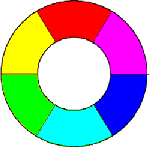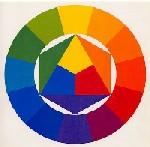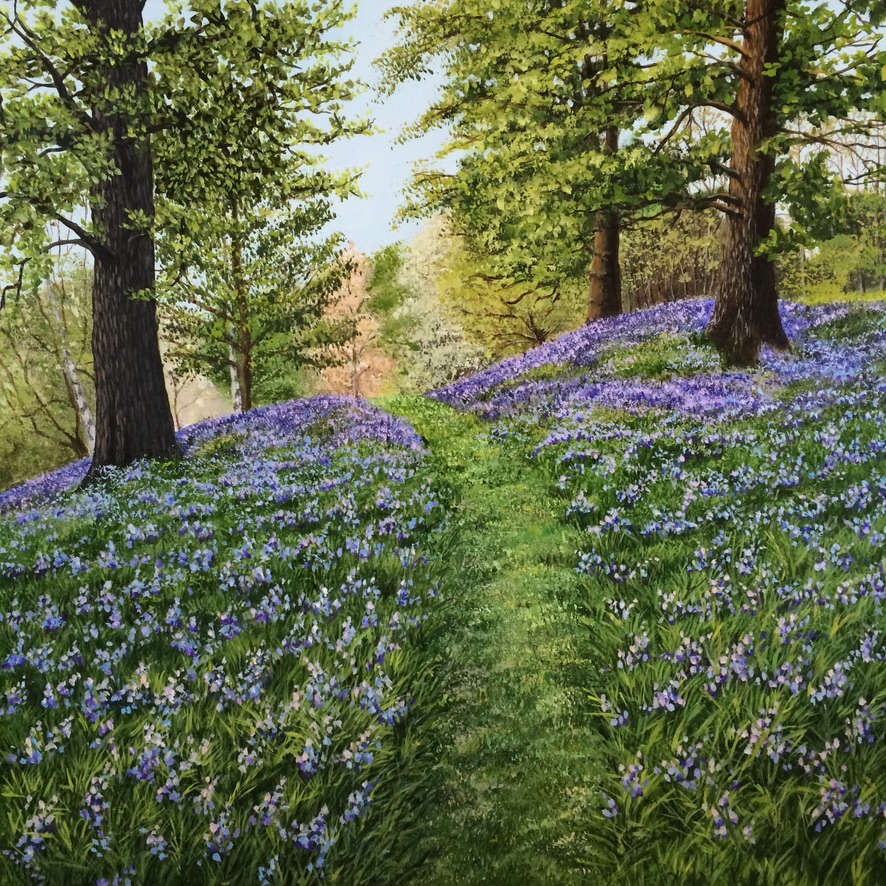Although most people may not realize it, there are two well-known color mixing systems. The primary colors depend on the color mixing system used.
- Printing primaries; in color printing, cyan, magenta, and yellow are considered primary colors.
- Painting primaries; In painting, red, blue, and yellow are commonly considered primary colors.
|

Color Wheel in Printing
When using printing inks, color mixing occurs scientifically, starting from the "true" primary colors. The true primary colors, from light to dark, are yellow, cyan (a sky-blue tint), and magenta (a very bright pink). Mixing two primary colors results in the true secondary colors, from light to dark: green (from yellow and cyan); red (from yellow and magenta); and blue (from cyan and magenta). The true pairs of complementary colors are opposite each other: yellow-blue; cyan-red; and magenta-green. Since the primary colors are lighter than the secondary colors, the circle does not transition evenly from light to dark. Mixing inks at the points of an equilateral triangle, randomly rotated around the center of the circle, theoretically produces the color black. However, in practice, more brownish tones are likely to emerge. Therefore, besides magenta, cyan, and yellow ink, black ink is always used.
|

Color Wheel in Painting.
The traditional color wheel depicted here consists of six colors: red, orange, yellow, green, blue, and purple. The primary colors red, yellow, and blue form a triangle. The same applies to the secondary colors orange, green, and purple. Complementary colors are positioned opposite each other. Red is opposite green, yellow is opposite purple, and orange is opposite blue. However, this still widely used system is scientifically incorrect; it is a result of the historical development of color theory. In the 18th century, when color theory became a subject taught in academies, there were only two relevant lightfast saturated pigments available: vermilion and ultramarine. However, these had the wrong hues. Nevertheless, for the artist, achieving a desired color can only be done through conscious or unconscious application of the scientific system. This poses few problems in practice because the terms "red" and "blue" are loosely used. For example, if a painter wants to mix orange, they will take a red from the tube and mix it with a warm yellow. However, if they want to make purple, the painter, relying on intuition and experience, will instead choose a bluish "red" (actually a tint leaning towards magenta, such as carmine), and mix it with a blue that already leans towards purple.
|

Classification of Colors.
Colors can be divided into three groups:
- Primary colors. In the color spectrum, three primary colors can be distinguished: red, blue, and yellow. All other colors can be obtained by mixing these three colors.
- Secundary colors. Colors that result from mixing two primary colors are called secondary colors. Colors opposite each other on the color wheel have opposing properties and are therefore called complementary colors.
- Tertiary colors kleuren.Tertiary colors are formed by mixing a primary and a secondary color.
|

Johannes Itten's Color Wheel
Johannes Itten's color wheel includes primary and secondary colors, as well as six tertiary colors: yellow-orange, red-orange, red-violet, blue-violet, blue-green, and yellow-green, totaling twelve colors. He names the primary colors as red, yellow, and blue. The secondary colors resulting from the mixing of two primary colors are orange, green, and violet. Tertiary colors, resulting from mixing a primary and a secondary color, are yellow-orange, red-orange, red-violet, blue-violet, blue-green, and yellow-green. However, Itten's color choices are not entirely correct concerning the selection of primary paint colors. Optimal mixing is not possible with the complementary.
|

Gerritsen's Color Wheel
Another well-known color wheel is Gerritsen's, based on primary lights, containing six colors. The primary colors are red, blue, and green (blue is also called violet). The secondary colors resulting from mixing two primary colors are magenta-red, cyan-blue, and lemon-yellow. Tertiary colors result from mixing a primary and a secondary color. Gerritsen's chosen colors offer optimal possibilities for explaining color theory and achieving maximum results when mixing colors.
|









 The colorwheel
The colorwheel